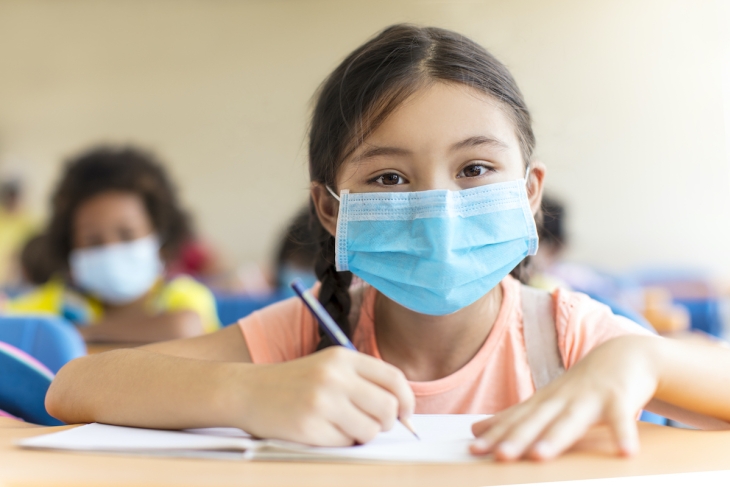Editor’s note: This is the third in a series of posts about envelope-pushing strategies that schools might embrace to address students’ learning loss in the wake of the pandemic. Find the first two posts here and here.
Last week I (re)stated the case for adding a year to elementary school, now and forever. That’s both because, even pre-Covid-19, we hadn’t succeeded in getting most kids to grade level standards before entering middle school, and post-Covid learning loss is going to make matters much worse. I fervently hope that states give the green light for at least a handful of schools to try this experiment in extended learning time.
But even if that is a bridge too far for most schools, there’s no getting around the particular education challenges facing today’s five-year-olds, what we might call the Covid Kindergarten cohort, especially in districts whose schools have been shut tight all year and are likely to stay that way.
The parents of these kids faced two terrible options back in the fall: either enroll their children in “remote kindergarten”—a poor simulacrum of the real thing—or “redshirt” them and keep them out of kindergarten entirely.
We don’t have perfect data, but according to an NPR survey, about one in six parents did the latter; about 16 percent of kindergarten-age students were not enrolled in school this past fall and presumably are not today. If we return to business as usual and simply keep kids on the normal age-based grade-level-progression conveyor belt, that means the current kindergarten cohort (the high school graduating class of 2033) will always be about 16 percent smaller than others, and next year’s kindergarten cohort (the class of 2034) will always be about 16 percent bigger.
So what’s the problem? Surely schools can add or subtract classrooms, or expand or shrink class sizes, like they always have. That’s true, but there are still major concerns that we shouldn’t sweep under the rug:
- Children who are doing remote kindergarten this year are surely missing some important skills and milestones (like learning how to behave at school!) and will therefore be heading into first grade even further behind than normal. Without extra help, they could end up struggling (academically, socially, and emotionally) for their entire schooling experience—punished, in effect, because their parents didn’t redshirt them.
- Children who were red-shirted will enjoy the benefit of entering kindergarten a year older than normal—making it more likely that they will be ready for grade-level material (if traumatized by the plague year). But that extra maturity can cut both ways. Some of those kids are going to be ready to be challenged beyond the kindergarten curriculum, and will be bored if they are not.
- Meanwhile, many of next year’s “normal age” kindergarteners will have missed out on preschool, making them even less kindergarten-ready than usual. Which is a huge challenge, given the low rates of kindergarten readiness even in the pre-Covid-19 world.
Put that all together and it means that we will have a group of kids—about 8 million four- and five-year-olds—entering post-Covid schooling with an unusually wide range of readiness levels. If there was ever a case for allowing students to move at their own pace, this situation must be it.
One option is for schools to adapt my plan from last week—adding a “grade 2.5” forever—but use that strategy for just a few years. Here’s how it might work in a given district:
- Make a commitment to adding an extra grade level between second and third grade for this year’s kindergarten class, and next year’s. That means in the 2023–24 and 2024–25 school years.
- This summer, work with early elementary teachers to adjust the scope-and sequence of the district’s core curriculum to spread out learning objectives for grades K–2 over four years instead of three.
- Implement that slower pace of instruction starting in kindergarten and first grade in 2021–22, then first and second grades in 2022–23, and grades 2 and 2.5 in 2023–24, to ensure that students master critical knowledge and skills.
- Make grade 2.5 the “default,” so that no student feels stigmatized for following that grade-level progression. There should be no talk of them being “held back” because that’s not what’s happening. They are being given an extra year to make up for the year lost to Covid-19.
- But do make sure that students who are ready to progress faster are able to do so, skipping grade 2.5 if they are ready for grade three.
In some ways, adding an extra grade for just a few years will create greater logistical challenges than doing it forever. That’s because it will create a few bizarrely sized cohorts that schools up and down the system will have to cope with. The high school graduating class of 2033, today’s kindergarteners, will be tiny, given that most of its students will do grade 2.5, slowing them down a year. And the high school graduating class of 2035 will be huge, given that it will include most of next year’s kindergarten cohort, who will get an extra grade level of elementary schooling, and all of the cohort after that (who will not). On the upside, this sort of experiment will cost a lot less money than adding an extra grade level till the end of time.
As crazy as this idea sounds, it still maintains our age-old commitment to “grade levels.” In coming weeks we’ll look at how we might get away from such shackles and create a system that truly gives each individual child of the Covid Generation what he or she needs.


